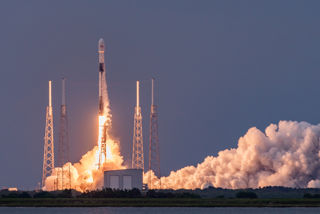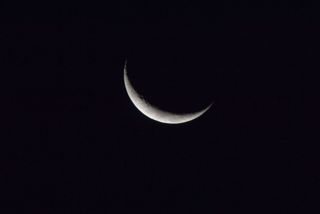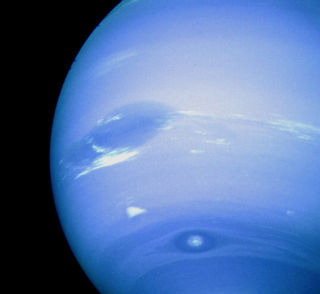
What's Happening in Space: September 2024
- 2nd Sep 2024
- Author: Dhara Patel
A summary of space events through the month
Dhara Patel is a Space Expert at the National Space Centre, working to help share space science, stories, and topical news with our visitors and online audiences. Each month she curates a round-up of some notable space and science events coming up the weeks ahead.
There are some fascinating events coming up this September, including a chance to spot the International Space Station and the SpaceX Crew 9 launch...
Throughout September – spot the International Space Station
There are a number of ISS pass sighting opportunities during the first week of September, and there may be more throughout the month – please use NASA’s Spot the Station to find out when and where to spot the largest artificial satellite overhead.
Early September – Polaris Dawn mission
In this first mission of the Polaris Program, named Polaris Dawn, the four astronauts on board will achieve the highest Earth orbit by a crewed spacecraft since Gemini 11 in 1966. It will also attempt the first spacewalk by a private astronaut. Funded and commanded by the billionaire Jared Isaacman, the mission will be operated by SpaceX – using a modified crew dragon module and new EVA (Extra Vehicular Activity) spacesuits. Polaris Dawn has been facing delays for the past two years and more recently due to astronauts Barry Wilmore and Sunita Williams awaiting return from the ISS after their Boeing Starliner vehicle experienced several issues on launch.
It was scheduled for late August and due to take off from Cape Canaveral Space Force Station, USA on a Falcon 9 rocket, but the mission has been postponed due to some technical issue, then unfavourable weather forecasted for Dragon’s splashdown and now completion of a mishap investigation by the Federal Aviation Administration, which grounded the Falcon 9 rocket after a failed booster landing attempt at sea earlier this week. Joining Isaacman will be pilot Scott Poteet, and mission specialists Sarah Gillis and Anna Menon. They will spend up to five days in orbit supporting scientific research designed to advance both human health on Earth and our understanding of human health during future long-duration spaceflight. And they’ll be the first to test Starlink laser-based communications in space. Find out more about the Polaris Dawn mission in this blog by Ed Turner in our Education team: https://www.spacecentre.co.uk/news/space-now-blog/polaris-dawn/

3rd September – new moon (2:55am)
The new moon will occur in the constellation of Leo. Without moonlight interference, it’s a great time to try and view deep sky objects. We have a blog on ‘phases of the moon’ written by Mike Darch in our Space Comms team: https://spacecentre.co.uk/blog-post/moon-phases/
5th September – Moon and Venus close in the sky
During the late morning of 5th September, the thin waxing crescent moon will be in conjunction (sharing the same right ascension – coordinate) with Venus, but the pair will be up in the daytime sky, so not visible from the UK. Rather, you can try to catch the Moon and Venus in close proximity just after sunset in the west, when the pair will be just above the horizon. A clear view without tall buildings or trees that may block your view, will help you spot the pair more easily. The duo will be too widely separated to fit within the field of view of a telescope, but will be visible to the naked eye and possibly through a pair of binoculars together. Find out more about conjunctions and other astronomical phenomena in our blog written by David Southworth in our Education Team: https://www.spacecentre.co.uk/news/space-now-blog/astronomical-phenomena/.
8th September – Saturn at opposition
Because Earth and Saturn have different orbits and orbital speeds, the distance between them is constantly changing. On 8 September, appearing in the constellation of Aquarius, Saturn will be on the opposite side of the Earth compared to the Sun so it will roughly be at its closest approach to Earth and its face will be fully illuminated by the Sun. The Sun, Earth, and Saturn will be in ‘syzygy’ or a roughly straight-line configuration. At the time of opposition, Saturn will be brighter than at any other time of the year and will be up all night long making it the best time to view and photograph the planet. Catch the spectacle from the late evening on 7 September – it will rise in the east and set in the west the following morning so ideally look towards the south around midnight. It won’t be very high above the horizon so clear views without trees and buildings to block your view would be helpful. Check out the astronomical phenomena blog above to find out more about oppositions and other astronomical phenomena.

13th September – EU/SpaceX, Falcon 9: Galileo satellites launch
Galileo is a global navigation satellite system that went live in 2016. It was created by the European Union through the European Space Agency (ESA) and operated by the European GNSS Agency (GSA) with the aim of providing an independent high-precision positioning system so European nations don’t have to rely on GPS (from the Unites States), or the Russian GLONASS systems, which could be disabled or degraded by their operators at any time. The second of two SpaceX Falcon 9 launches (the first of which launched in April 2024) is set to take a pair of satellites into orbit taking off from Cape Canaveral in Florida on 13 September. These missions mark the first time in 15 years that Galileo spacecraft have launched from a non-European territory and the first times that SpaceX has launched EU satellites carrying classified equipment. Originally planned to launch on Soyuz ST, but scrapped due to geopolitical factors it was then moved to Ariane 6, which was then also scrapped due to delays. Currently there are 23 operational satellites, and in its final form, Galileo will feature 30 spacecraft — 24 active satellites and six orbiting spares.
17th September – Moon and Saturn close in the sky
During the late morning of 17 September, the waxing gibbous moon will be in conjunction (sharing the same right ascension – coordinate) with Saturn and the pair will be at their closest angular separation (close approach) around the same time. From the UK, they’ll be below the horizon at this time so won’t be visible. Instead try to catch the Moon and Saturn in close proximity, looking towards the west during the early morning hours before sunrise. The pair will be close to the horizon as they prepare to set so clear views without tall buildings or trees that may block your view, will help you spot the pair more easily. The duo will be too widely separated to fit within the field of view of a telescope and likely a pair of binoculars, but will be visible to the naked eye. Check out the astronomical phenomena blog linked above to find out more about conjunctions and close approaches.
18th September – full moon (3:34am), supermoon and partial lunar eclipse
Known as the Harvest moon (according to the old Farmers’ Almanac), this full moon is named after the time of year that farmers would start to gather or harvest their crops. Check out the “Full Moon: Full Facts” blog written by Mike Darch in our Space Comms team to find out more about full moons: https://spacecentre.co.uk/blog-post/full-moon-facts/.
This month’s full moon is also a supermoon. Due to the Moon’s elliptical orbit and it’s shifting movement (precession), when a full moon occurs around the time that the Moon is also at its closest position to Earth in its elliptical orbit, we’re treated to a supermoon where our lunar neighbour appears slightly bigger and brighter. The Moon will rise around sunset and move from east to west throughout the night, setting as the sun rises – so will be visible from dusk till dawn
Additionally, we’ll be treated to a small partial lunar eclipse too. Around 3:45am look to the southwest to spot a small ‘bite’ being taken out of the Moon’s top right edge as it passes behind the Earth and slightly into the inner part of our planet’s shadow known as the umbra. Find our more about lunar eclipses in this blog written by Daniel Milankovic – one of NSC's Duty Managers: https://www.spacecentre.co.uk/news/space-now-blog/what-is-a-lunar-eclipse/

21st September – Neptune at opposition
Because Earth and Neptune have different orbits and orbital speeds, the distance between them is constantly changing. On 21 September, appearing in the constellation of Pisces, Neptune will be on the opposite side of the Earth compared to the Sun so it will roughly be at its closest approach to Earth and its face will be fully illuminated by the Sun. The Sun, Earth, and Neptune will be in ‘syzygy’ or a roughly straight-line configuration. At the time of opposition, Neptune will be brighter than at any other time of the year and will be up all night long making it the best time to view and photograph the planet. It will still appear faint, and you’ll need a telescope to see the blue point of light that lies over 4 billion km from us. Catch the spectacle from the late evening on 21 September – it will rise in the east and set in the west the following morning so ideally look towards the south around midnight. Check out the astronomical phenomena blog above to find out more about oppositions and other astronomical phenomena.
22nd September – autumnal/vernal equinox (1:43pm)
The Sun crosses the celestial equator going north to south, marking the first day of astronomical autumn for the northern hemisphere. The length of day and night are almost equal, and the autumnal equinox marks the end of summer in the UK. From now, the hours of daylight will shorten each day as we approach the winter solstice in December. Find out more about equinoxes in this blog by Catherine Muller in our Space Comms team: https://spacecentre.co.uk/blog-post/equinoxes-and-solstices/
23rd/24th September – Moon and Jupiter close in the sky
Just after midnight on 24th September, Jupiter will be in conjunction (sharing the same right ascension – coordinate) with the waning gibbous moon. They will also be at their closest angular separation (close approach) just before midnight so try to catch the pair together in the eastern sky as the day ends and the next one begins. The pair will rise higher into the sky throughout the night becoming easier to see especially if there are tall buildings or trees blocking your view of the horizon. The duo will be too widely separated to fit within the field of view of a telescope or a pair of binoculars but will be visible to the naked eye. Check out the astronomical phenomena blog linked above to find out more about conjunctions and close approaches.
24th September – SpaceX Crew-9 launch
The ninth crewed operational flight of a SpaceX Crew Dragon spacecraft to the International Space Station as part of NASA’s Commercial Crew Program has been altered due to issues with the Boeing Starliner crew flight test and its two astronauts (Sunita Williams and Barry Wilmore) requiring an alternative ride back home. Both SpaceX Crew Dragon and Boeing Starliner were contracted by NASA to take astronauts to and from the ISS – and while SpaceX have developed, tested, and been ferrying astronauts since 2020, Boeing are yet to complete a successful crewed flight and become operational. Look out for a blog on being stranded in space by Joseph Walters, one of our science interpreters on the National Space Centre website very soon: https://www.spacecentre.co.uk/news/space-now-blog/
Please note: As this summary is created at the end of the month before, dates (especially launch dates) can often change or be updated, so this content may become outdated - we always recommend checking on the relevant organisation's pages.
